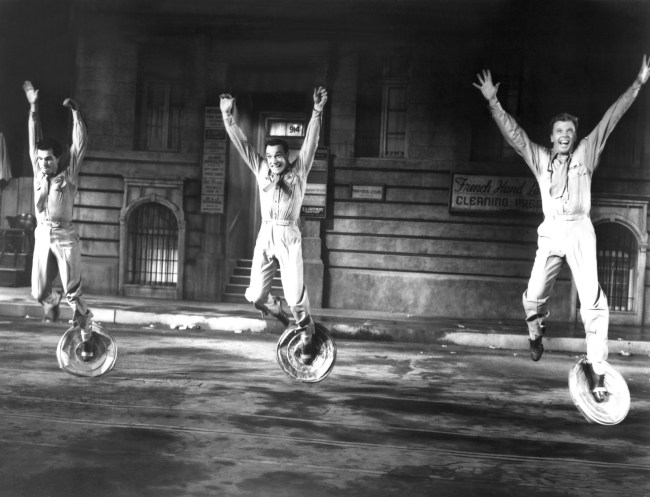It’s Musicals Week at IndieWire. With “Wicked” about to sparkle over theaters, we’re celebrating the best of the movie-musical genre.
Nowadays, trying to make a musical about post-war malaise, divorce, the corporatization of television, and friendships come and gone may seem like an intriguing prospect, but in the golden age of the Hollywood musical during the 1940s and ’50s, there was little room for the form to take on subjects outside of pride in America, falling in love, or putting on a show. In a way, “It’s Always Fair Weather” does feature all of these components, but the way it subverts these themes to craft an indictment of 1950s American culture is what sets it apart as one of the most unique and honest musicals of the 20th Century.
Initially conceived as a sequel to the 1949 wartime Technicolor musical “On the Town,” starring Gene Kelly, Frank Sinatra, and Jules Munshin and marking the directorial debuts of Kelly and choreographer Stanley Donen, “It’s Always Fair Weather” quickly turned into a creation all its own. Most of the major musicals of this era came as a product of MGM and its Freed Unit, run by producer Arthur Freed, who helped contribute to the success of “The Wizard of Oz,” “Meet Me in St. Louis,” “Singin’ in the Rain,” and many more. But by the mid-1950s, the popularity of the genre as well as Freed’s influence on it was starting to wane. MGM’s president at the time, Dore Schary, saw the writing on the wall and exercised his power over the production, refusing to allow Sinatra or Munshin to be cast and insisting on a much less lavish vision than what Kelly and Donen had accomplished with their previous collaborations.
Rather than feel boxed in by these parameters, Kelly and Donen felt emboldened to tell a more grounded, downbeat narrative that reflected the realities of post-war life for many veterans and their compatriots. (There’s a reason Kelly’s widow Patricia Ward Kelly thinks he would have liked “Emilia Perez.”) Instead of going after big stars, Kelly recruited fellow dancers like himself, including Dan Dailey, who was already on contract to MGM, and Michael Kidd, who had choreographed “The Band Wagon” and Donen’s recent hit, “Seven Brides for Seven Brothers,” but never acted before. The three star as G.I. soldiers who return to New York City after World War II bright-eyed and bushy-tailed, ready to conquer their dreams, only to become versions of themselves they never imagined being. As the film fast-forwards 10 years, the friends reunite, embarrassed to find they no longer have anything in common and turned off by the notion that they were even close in the first place. However, an advertising executive, played by a confident, self-assured Cyd Charisse, catches wind of the men’s reunion and realizes it’ll make the perfect segment for a TV show she’s putting together later that evening.
At this point in the film, the characters are split up, sent on personal journeys of self-discovery that force them to reckon with what the world, particularly America, has made them. In this way, “It’s Always Fair Weather” serves to reflect a struggle Kelly and Donen were both facing at the time as pioneers of a form that was fledgling. With the advent of TV came variety shows, which pulled film musical audiences away from theaters in a similar way to how streaming has effected the overall theatrical experience today. In reaction to this, Kelly and Donen, as well as screenwriters Betty Comden and Adolph Green, satirize TV’s cheapness throughout the film, highlighting how it values consumerism over art and nuance, thereby contributing to America’s growing materialism and social disconnection.
Writing of how the film compares to their previous efforts in her exquisitely crafted history of the genre, “The Movie Musical,” American film historian Jeanine Basinger wrote, “‘Singin” has a nostalgic, loving sense of Hollywood’s past and a tolerance for its foibles. ‘Fair Weather’ is angry at the competition from TV, openly scorning its goals and its audiences. Running underneath the story of friendship gained, friendship lost, and friendship regained is a depressing sense of something good that America had lost, and the something mean and small that had grown in its place.”
Added to his woes going into production, Kelly had signed a contract with MGM after the success of “An American in Paris” in 1951 that sent him to Europe for almost two years to make three films with funds that were frozen there, none of which were immediately released. By the time he returned to Hollywood, musicals were feeling the squeeze television was putting on them and Kelly had become less of a box office draw. MGM’s refusal to loan him out for “Guys and Dolls” and “Pal Joey” also strained his relationship with the studio, so by the time they agreed to make “It’s Always Fair Weather,” he really had nothing to lose. This go-for-broke attitude is reflected in both the narrative, which challenges traditional tropes, and the choreography, which makes use of trash-can lids and roller-skates for two of the greatest tap numbers ever committed to screen.
The film’s boldest feature, however, is the cinematic techniques on display by Donen, who uses CinemaScope and Eastman Color to dazzling effect, elevating sequences with visual inventiveness or letting his camera find a natural rhythm in following his actors as they tear up the MGM backlot. Somewhat ironically, the only reason Donen felt such control over how the film was shot was because of how poor his relationship with Kelly had gotten. They had always had a contentious working dynamic, but things turned personal when Kelly was rumored to have started an affair with Donen’s wife Jeanne Coyne. Donen would divorce Coyne in 1951, and she and Kelly carried on the affair despite Kelly being married to Betsy Blair. Finally, Blair and Kelly would divorce in 1957, allowing him to marry Coyne in 1960. In between all this, and largely a result of the greater power Kelly and Donen carried together than apart, they chose to reunite for what turned out to be one last ride.
In recognition of the rift between them and wishing to remain conciliatory for the sake of production, they both ceded control over certain elements, each making their own imprint on the film without getting in the way of one another. Kelly and Donen’s strife and appreciation end up getting reflected back into the film as the three former soldiers not only learn to become more accepting of one another, but are eventually reminded that, despite their differences, there’s no one they’d rather be in the trenches with than each other. In reality, this would be the last time Kelly and Donen suited up for battle together and the last time either worked for MGM. They would both go on to direct more musicals, Donen with “Funny Face” and “Damn Yankees!” and Kelly with “Hello, Dolly!”, but none matched the heights they reached together.
“It’s Always Fair Weather” may not have had the same impact as their previous collaborations, but it stands as an example of their prowess personified, a testament to not only the power of song-and-dance, but a strong rebuke of Hollywood’s rose-colored outlook. The songs featured — from Dailey’s alcohol fueled breakdown in “Situation-Wise” to Dolores Gray’s violently cartoonish 11 o’clock number “Thanks a Lot, but No, Thanks” — juxtapose a satirical cynicism with outlandish jauntiness, almost as commentary to the hum-drum lives each character finds themselves in. In this way, Kelly and Donen make a clear-eyed statement on the power of musicals to awaken us from the stasis society often puts us in and bring forth the emotions we so often work to avoid facing.


